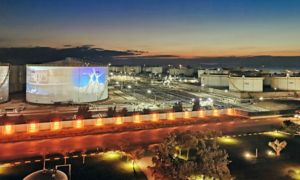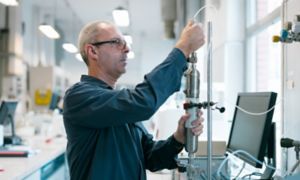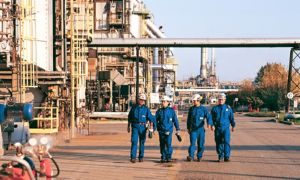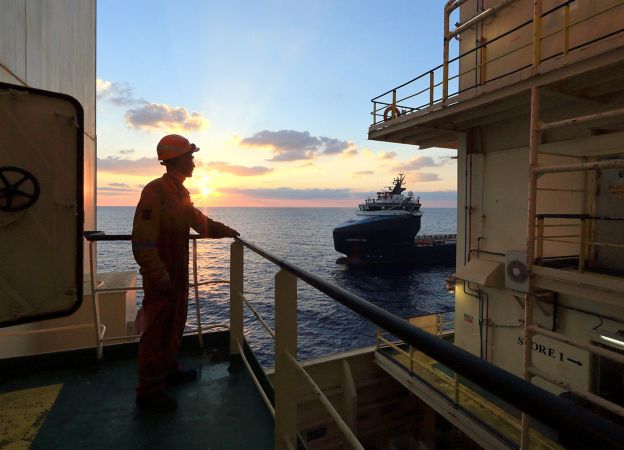13,02
mln euro
proforma adjusted EBIT - Exploration & Production

Or , our new artificial intelligence tool.
Exploration efficiency allows us to remain competitive even in the most challenging energy scenarios.

Energy derived from natural resources such as hydrocarbons remains a necessary tool to ensure access to energy for a world that is growing in terms of demographics and consumption. Even in its Net Zero scenario, the most challenging for reducing greenhouse gas emissions, the International Energy Agency (IEA) predicts that Oil & Gas will remain necessary even in 2050, albeit with a more limited production. At the same time, it is essential to apply the best available technologies to these activities for energy efficiency and emission reduction, for example with CO2 capture, storage, and utilization (CCUS) projects.
Exploration remains what sets Eni apart and is a strategic driver of the decarbonization pathway, in the dual role of guaranteeing the replacement of the reserves produced to ensure the energy supplies the Company needs during the transition, and aligning the resource portfolio with the objectives of the production mix and medium- to long-term emission profiles consistent with the Net Zero target.
In particular, natural gas remains central to our production mix, supporting energy security and value creation in the long term. Among fossil fuels, gas has the lowest carbon footprint, assuming a role in supporting the energy transition. For this reason, the gas component will be increasingly present in our hydrocarbon production.
Final production is the goal of our operations right from the exploration stages: by integrating the studies of our Research Centres and the analysis capacity of HPC6 supercomputer, we acquire advance information on the potential field in order to design the development right away. The field is then gradually brought into production so that the new infrastructures can be incorporated and production capacity consequently increased. Exploring and extracting from the site quickly allows us to provide a rapid response to the demand for energy. With this in mind, the Dual Exploration Model allows us to anticipate cash flow by divesting minority interests in the fields, thus obtaining useful resources to be reinvested and making the process even more efficient.
In more technical terms, the success of our development model is based on:
The field must be put into production in order to retrieve the hydrocarbons, drilling an optimal number of production wells and installing the necessary equipment to remove any unwanted components (such as solid particles, water, salts, etc.) from the gas and oil and separate the liquid phase of the oil from the gas phase. Development operations at sea are more complex, with production wells being drilled from various kinds of fixed platforms (steel, concrete, semi-submersible or even anchored with cables) that are often extremely large and channelled in such a way as to drain the largest possible area from a single station.
(barrel of oil equivalent) hydrocarbon production in 2024
resources discovered in Oil & Gas in 2024 (billion barrels of oil equivalent)
(billion cubic feet) annual natural gas production (2024)
in upstream production by 2030
total heavy oil conversion rate in Sannazzaro de' Burgondi refinery
Annual Report 2024
proforma adjusted EBIT - Exploration & Production
Cash flow per Boe - Exploration & Production
Highlights Full Year 2024
daily production hydrocarbon
adjusted cash flow
proforma adjusted EBIT
leverage proforma
The recovery of hydrocarbons from fields takes place with the optimal number of production wells, accompanied by the necessary equipment. Once extracted, the hydrocarbons are processed and sent to the market via pipelines or ships or are stored as an energy reserve. The global energy market requires rapid response times. The time-to-maket, the time required to actually start selling hydrocarbon production, must be as fast as possible. In addition to the economic benefits, reducing time-to-market can generate environmental benefits by minimising on-field activities. In the context of natural gas, it also means accelerating the increase of the share of gas in the production mix.
In order to speed up this phase as much as possible, we use the fast track development model, which involves running the assessment and engineering development phases in parallel thanks also to the infrastructures already present in the area.
Furthermore, we use a modular approach with early production, followed by a gradual ramp-up. This exploration model ensures a time-to-market of approximately three and a half years from the discovery of a reservoir to its commissioning, about half the average in the energy industry.
A key role in the net zero process is played by natural gas thanks to its flexibility and accessibility.
Production operations, whereby the hydrocarbons are extracted from the deposit, processed at the plants and sent to the market by pipeline or ship, follow the development stage. The productive life of a deposit can last for decades, during which it will be continuously monitored and work carried out within the wells to optimise production, sometimes including advanced recovery projects that involve injecting gas or water to increase the quantity of hydrocarbons that can be retrieved.
For our production activities, we implement initiatives to monitor and reduce fugitive methane emissions and implement energy efficiency initiatives through our technologies. In doing so, we are meeting our decarbonization commitments aimed at achieving Net Zero Emissions (Scope 1+2) for the upstream natural gas business by 2030. The CO₂ capture and storage projects and the solutions developed by our Research Centres contribute to the reduction of net emissions, while Carbon Offset Solutions compensate for residual emissions.
By investing in cutting-edge exploration technology, we gain an ever deeper knowledge of the subsoil.
The supply of natural gas to consumer markets relies on an integrated infrastructure system consisting of a network of pipelines connecting Europe to the main producing countries and a fleet of four ships for the transport of liquefied natural gas (LNG) operating globally from the Americas to the Far East. The integration of these two complementary transportation systems ensures a continuous and stable gas supply, even in complex market environments. The pipelines, developed over time through international collaborations and managed by joint ventures involving multiple companies and countries, guarantee a direct link between the main energy hubs and the destination markets.
At the same time, the flexibility that characterises liquefied natural gas is a strategic element for diversifying supply sources. Eni’s fleet operates on a global scale in collaboration with third-party shipowners and under direct management, allowing for swift and effective responses to market dynamics through flexible contracts and diversified routes. This approach strengthens Eni’s presence in the LNG sector, helping to ensure energy security for Italy, Europe and other geographical areas. Furthermore, all the ships mentioned are “Panamax,” a feature that enables them to transit the Panama Canal, facilitating the transport of LNG from regional to global markets, adapting to international supply and demand fluctuations.

If you want to change topic, clear the chat and make a new query to receive more relevant results.
This will delete the question history.
If you want to change topic, clear the chat and make a new query to receive more relevant results. This will delete the question history.
Here you can find the full list of your queries.
The answers are generated by artificial intelligence, therefore they may contain inaccuracies. Please read the terms and conditions of use.

EnergIA is an innovative tool based on artificial intelligence capabilities, which can help you navigate the contents of eni.com, quickly finding answers to your questions. EnergIA can also perform a search on a specific topic, providing the most up-to-date data available, or it can invite you to delve deeper into a topic of your interest by suggesting links and specific readings. Start now!
EnergIA is an innovative tool based on artificial intelligence capabilities, which can help you navigate the contents of eni.com, quickly finding answers to your questions. Start now!
EnergIA (ener'dʒia) is a system based on Generative Artificial Intelligence.
Thanks to this technology, we can respond to your requests by querying the most relevant content and documents available on eni.com. (Note: financial documents from the last 12 months and press releases from the last 2 years are considered.)
Through EnergIA, you can delve into topics of interest and have a real-time window into the world of Eni.
If you wish to search for a specific document, press release or news, use the traditional search engine via the magnifying glass icon.
Like all systems that leverage Generative Artificial Intelligence, EnergIA may generate inaccurate or outdated responses. Always consult the sources that EnergIA proposes as the origin of the generated information.
If the system fails to find an exact match for the requested content, it still tends to provide a response.
If you find any inaccuracies in the provided response, please send us your feedback at the bottom of the page: it will be very helpful for us to improve.
Remember that the content generated by the system does not represent Eni’s official position. We therefore invite stakeholders to refer to their designated contacts for official statements: Press Office for journalists, Investor Relations for analysts and investors, Company Secretariat for shareholders etc..
EnergIA can understand questions posed in almost all languages, but we prefer to provide you with a response in English or Italian, the two languages available on eni.com. If you ask a question in Italian, the content on the site in Italian will be consulted. If you ask it in English or any other language, the content in English will be consulted. (Note: the language Eni uses for financial documents/content is predominantly English.)
If questions are formulated that violate the set security criteria, the system will not proceed with processing the response. Please remember not to send personal data.
By using this service, the users acknowledge that they have read and accepted the terms and conditions of use.
Search
EnergIA (ener'dʒia) is a system based on Generative Artificial Intelligence.
Thanks to this technology, we can respond to your requests by querying the most relevant content and documents available on eni.com. (Note: financial documents from the last 12 months and press releases from the last 2 years are considered.)
Through EnergIA, you can delve into topics of interest and have a real-time window into the world of Eni.
If you wish to search for a specific document, press release or news, use the traditional search engine via the magnifying glass icon.
Like all systems that leverage Generative Artificial Intelligence, EnergIA may generate inaccurate or outdated responses. Always consult the sources that EnergIA proposes as the origin of the generated information.
If the system fails to find an exact match for the requested content, it still tends to provide a response.
If you find any inaccuracies in the provided response, please send us your feedback at the bottom of the page: it will be very helpful for us to improve.
Remember that the content generated by the system does not represent Eni’s official position. We therefore invite stakeholders to refer to their designated contacts for official statements: Press Office for journalists, Investor Relations for analysts and investors, Company Secretariat for shareholders etc..
EnergIA can understand questions posed in almost all languages, but we prefer to provide you with a response in English or Italian, the two languages available on eni.com. If you ask a question in Italian, the content on the site in Italian will be consulted. If you ask it in English or any other language, the content in English will be consulted. (Note: the language Eni uses for financial documents/content is predominantly English.)
If questions are formulated that violate the set security criteria, the system will not proceed with processing the response. Please remember not to send personal data.
By using this service, the users acknowledge that they have read and accepted the terms and conditions of use.
A new window into Eni’s world, at your disposal. EnergIA is an innovative tool based on artificial intelligence capabilities, which can help you navigate the contents of eni.com, quickly finding answers to your questions.




